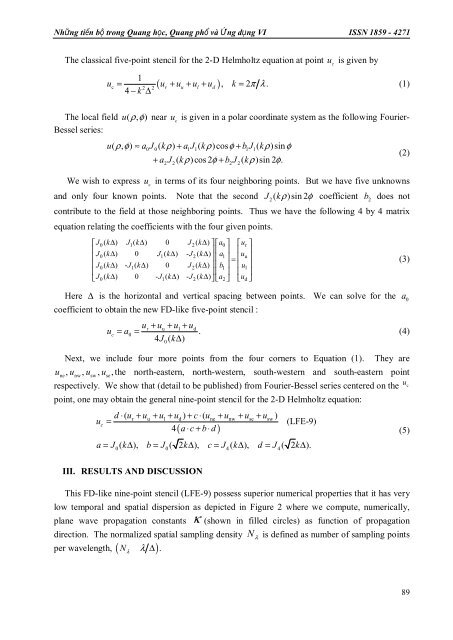Nhng tin b trong Quang hc, Quang ph và ng dng VI ISSN 1859 - 4271
Nhng tin b trong Quang hc, Quang ph và ng dng VI ISSN 1859 - 4271
Nhng tin b trong Quang hc, Quang ph và ng dng VI ISSN 1859 - 4271
You also want an ePaper? Increase the reach of your titles
YUMPU automatically turns print PDFs into web optimized ePapers that Google loves.
Nhữ<strong>ng</strong> tiến bộ <stro<strong>ng</strong>>tro<strong>ng</strong></stro<strong>ng</strong>> <stro<strong>ng</strong>>Qua<strong>ng</strong></stro<strong>ng</strong>> học, <stro<strong>ng</strong>>Qua<strong>ng</strong></stro<strong>ng</strong>> <stro<strong>ng</strong>>ph</stro<strong>ng</strong>>ổ và Ứ<strong>ng</strong> dụ<strong>ng</strong> <strong>VI</strong> <strong>ISSN</strong> <strong>1859</strong> - <strong>4271</strong>The classical five-point stencil for the 2-D Helmholtz equation at point ucis given by1uc =2 2( ur + uu + ul + ud), k = 2 π λ .4 − k ∆(1)The local field u( ρ, φ ) near u is given in a polar coordinate system as the followi<strong>ng</strong> FouriercBessel series:u( ρ, φ) ≈ a0J 0( kρ) + a1 J1( kρ)cos φ + b1 J1( kρ)sinφ+ a J ( kρ) cos 2 φ + b J ( kρ)sin 2 φ.2 2 2 2We wish to express u in terms of its four neighbori<strong>ng</strong> points. But we have five unknownscand only four known points. Note that the second J ( kρ)sin 2φcoefficient 2b2does notcontribute to the field at those neighbori<strong>ng</strong> points. Thus we have the followi<strong>ng</strong> 4 by 4 matrixequation rela<s<stro<strong>ng</strong>>tro<strong>ng</strong></stro<strong>ng</strong>>>tin</s<stro<strong>ng</strong>>tro<strong>ng</strong></stro<strong>ng</strong>>>g the coefficients with the four given points.⎡J ( k∆) J ( k∆) 0 J ( k∆)⎤ ⎡a⎤ ⎡u⎤0 1 2 0 r⎢J0 ( k ) 0 J1( k ) - J2 ( k )⎥ ⎢a⎥ ⎢1 u⎥⎢∆ ∆ ∆⎥ ⎢ ⎥ = ⎢ u ⎥(3)⎢J0 ( k∆) - J1( k∆) 0 J2( k∆)⎥ ⎢b1⎥ ⎢ul⎥⎢ ⎥ ⎢ ⎥ ⎢ ⎥⎣ J0 ( k∆) 0 - J1( k∆) - J2 ( k∆)⎦ ⎣ a2⎦ ⎣ ud⎦Here ∆ is the horizontal and vertical spaci<strong>ng</strong> between points. We can solve for the a0coefficient to obtain the new FD-like five-point stencil :ucu + u + u + u= a0=4 J ( k∆)r u l d0.Next, we include four more points from the four corners to Equation (1).(2)(4)They areune, unw, usw , use,the north-eastern, north-western, south-western and south-eastern pointurespectively. We show that (detail to be published) from Fourier-Bessel series centered on thecpoint, one may obtain the general nine-point stencil for the 2-D Helmholtz equation:ucd ⋅ ( ur + uu + ul + ud ) + c ⋅ ( une + unw + use + usw)=4( a ⋅ c + b⋅d )0 0 4 4(LFE-9)a = J ( k∆ ), b = J ( 2 k∆ ), c = J ( k∆ ), d = J ( 2 k∆).III. RESULTS AND DISCUSSIONThis FD-like nine-point stencil (LFE-9) possess superior numerical properties that it has verylow temporal and spatial dispersion as depicted in Figure 2 where we compute, numerically,plane wave propagation constants κ (shown in filled circles) as function of propagationdirection. The normalized spatial sampli<strong>ng</strong> density N λ is defined as number of sampli<strong>ng</strong> pointsper wavele<strong>ng</strong>th, ( @ λ ∆).N λ(5)89















